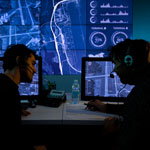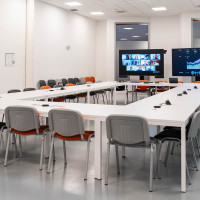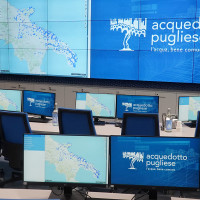
CONTROL ROOM
The control that increases performance
Solutions that monitor processes and acquire data to increase efficiency and security.
Whether it's a modern control room for a private company or a large operation room for top-level public utilities, setting up these environments requires targeted design to ensure efficient and effective big data management.
Designing a Control Room means creating an integrated digital ecosystem made up of consistent, interconnected devices, seamlessly harmonized with a well-planned layout of operator workstations. The goal is to build environments that are productive and proactive from an operational, visual, and ergonomic standpoint.
The technological setup — which includes supervisory, audio, video, and distribution systems on one side, and furnishings and their placement on the other — must be carefully designed to support 24/7 operations and reduce operator fatigue. This is how and why a corporate control room should be designed to manage Big Data efficiently.
A modern Control Room no longer serves merely to monitor systems — even highly complex ones such as production processes, road networks, or hospitals — but is now equipped to make predictions and thereby minimize risks.
For example, it's possible to predict when a machine might begin to malfunction based on its performance trends. Detecting this data in real time and scheduling maintenance — even automatically — helps prevent breakdowns.
Collecting large volumes of data alone is not enough: advanced visualization systems are essential to process and interpret data quickly, empowering operators to make strategic decisions. In other words, industrial supervision systems must be capable of anticipating faults and malfunctions, thus minimizing potential damage.
Visualization systems for control rooms and operation rooms range from desktop displays for control room operators to large-format videowalls and ledwalls, offering expansive viewing surfaces essential for efficiently and effectively monitoring multiple streams of information and making mission-critical decisions.
Image quality — in terms of color vibrancy and content clarity — is crucial to ensure the most accurate interpretation of visual data, especially during critical moments. For this reason, visualization systems represent the nerve center of all control rooms, paired with integrated redundant power supplies to ensure continuous operation, 24/7.
Increasingly complex and expansive systems generate massive volumes of data. The ability to visualize and manage this data effectively is a key factor in ensuring security and improving any process.
Designing Control & Operation Rooms involves not only assessing the most suitable technologies to implement but also analyzing the actual decision-making process carried out by room operators. The objective is to ensure efficiency and speed in decision-making, with an adequate level of security in data transmission and management.
When we consider infrastructure networks, connections, moving vehicles, communication systems, supply chains, services, industrial processes, and the increasing automation of systems, it becomes clear that the real challenge for Control Rooms is no longer just installing cameras and displaying feeds on a videowall — it's about effectively and efficiently managing the massive flow of data coming from a vast and heterogeneous array of sources.
The NOC (Network Operations Center) is the operational hub designed to monitor, manage, and maintain the technological infrastructure of an organization to ensure business continuity, as well as the availability and performance of networks and IT systems.
The SOC (Security Operations Center), on the other hand, is a specialized type of Control Room focused on cybersecurity. Its purpose is to monitor, detect, and respond to security threats and incidents that could compromise a company’s data, systems, and overall operations.
Although NOCs and SOCs serve different functions, collaboration between the two control rooms is essential. Network anomalies — such as slowdowns, malfunctions, or outages — can be early indicators of cyberattacks.
For this reason, both in their day-to-day operations and in moments of shared response, it's crucial for these centers to be equipped with the right technologies to ensure responsiveness and, more broadly, optimal protection of the organization.
To address these needs, Touchwindow designs integrated NOC and SOC environments, equipped with shared monitoring dashboards — with differentiated access based on privileges and user types — and systems for real-time data collection, processing, and analysis.
This architecture enables constant, bidirectional data and information exchange, facilitating collaboration and improving crisis response capabilities while minimizing potential damage.
Touchwindow designs next-generation control rooms, combining audio and video over IP architecture with KVM solutions that allow operators to interact with multiple systems from a single workstation. These technologies enable the sharing of AV resources and access to remote sites with minimal latency, ensuring seamless system response with no perceptible delay, which is crucial for executing preventive actions, reducing emergency response times, and mitigating risks.
In parallel, we design the physical environment by integrating technical furnishings tailored to the ergonomics of operator workstations and optimized layout planning based on operational and decision-making workflows.
The exponential growth of data requiring monitoring increases the need for collaborative decision-making. That’s why our Control Rooms can be equipped with custom control dashboards for each operator, adapted to their role, expertise, and access permissions. These dashboards enable bidirectional collaboration, transforming large volumes of incoming data into visually intuitive indicators, much like a car dashboard translates complex data into easily readable gauges and displays for optimal control.
Alongside the essential tech infrastructure, we provide large-format, multi-user, multi-touch tactical tables that integrate with all room systems. These are powered by real-time collaboration software, extending the collaborative capabilities both within and beyond the control room.
By conceiving the Control Room as an integrated and interconnected digital ecosystem, the vast amount of data generated through surveillance can be leveraged effectively. For instance, we integrate session recording systems for training and education purposes, or to assess operator performance and derive insights for process improvement.
From broadcasting to airports, military sectors to finance, public utilities to retail: Touchwindow’s scalable and flexible solutions are future-ready and designed to meet the specific needs of any application context.
Discover Touchwindow Control Room Solutions
https://www.touchwindow.it/it/solutions/control-room
Contact us to learn more!
What is a Control Room?
A Control Room – understood in all its different meanings such as Operation Room, Situation Room, NOC (Network Operations Center), or SOC (Security Operations Center) – is a space that lies between the physical and digital worlds, where systems, processes, or activities are monitored, supervised, managed, and controlled in real time.
The main function of a Control Room is to allow operators to monitor data and information flows in real time and to intervene immediately – or even predictively – when critical events occur.
To be efficient and effective in management and supervision, a Control Room must function as a hub where all data and signal flows (audio, video, etc.), both analog and virtual, converge with virtually no latency, whether they come from outside or inside the network.
Here, Control Room operators, using specific software for data aggregation, analysis, and visualization – along with Big Data – are able to make strategic decisions quickly in order to respond promptly to critical events or prevent them from happening.
Best practices in the design of an effective and efficient Control Room include the integration of the following technologies:
Large-format display systems with at least 4K UHD resolution, to ensure that all room operators have a clear view of every detail.
Audio-video over IP distribution systems for transmitting input and output signals to and from the control room stations and all remote monitoring stations in the field.
Dedicated stations or rooms for managing mission-critical situations, integrated and interconnected with the Control Room: multi-touch, multi-user tactical tables equipped with software for Big Data processing and real-time collaboration, or technologically advanced Crisis Rooms.
Customizable technical furniture, configurable according to the operational requirements of each workstation.

Solutions that monitor processes and acquire data to increase efficiency and security.

Touchwindow creates a turnkey installation at the DAMA Technopole in Bologna, featuring audio-video solutions, automation, and reconfigurable spaces.

Acquedotto Pugliese takes care of citizens and the territory every day, ensuring a more efficient and sustainable use of water resources. Room control is the digital heart of this system, as innovative as it is indispensable.